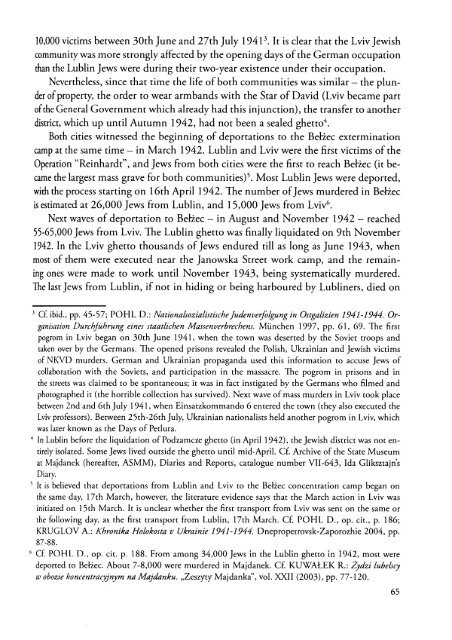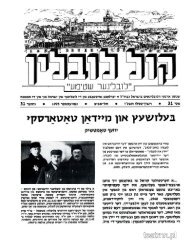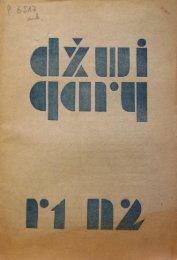The Jews in Lublin - Biblioteka Multimedialna Teatrnn.pl - Brama ...
The Jews in Lublin - Biblioteka Multimedialna Teatrnn.pl - Brama ...
The Jews in Lublin - Biblioteka Multimedialna Teatrnn.pl - Brama ...
You also want an ePaper? Increase the reach of your titles
YUMPU automatically turns print PDFs into web optimized ePapers that Google loves.
10,000 victims between 30th June and 27th July 1941 3 . It is clear that the Lviv Jewish<br />
community was more strongly affected by the open<strong>in</strong>g days of the German occupation<br />
than the Lubl<strong>in</strong> <strong>Jews</strong> were dur<strong>in</strong>g their two-year existence under their occupation.<br />
Nevertheless, s<strong>in</strong>ce that time the life of both communities was similar - the <strong>pl</strong>under<br />
of property, the order to wear armbands with the Star of David (Lviv became part<br />
of the General Government which already had this <strong>in</strong>junction), the transfer to another<br />
district, which up until Autumn 1942, had not been a sealed ghetto 4 .<br />
Both cities witnessed the beg<strong>in</strong>n<strong>in</strong>g of deportations to the Bełżec exterm<strong>in</strong>ation<br />
camp at the same time - <strong>in</strong> March 1942. Lubl<strong>in</strong> and Lviv were the first victims of the<br />
Operation "Re<strong>in</strong>hardt", and <strong>Jews</strong> from both cities were the first to reach Bełżec (it became<br />
the largest mass grave for both communities) 5 . Most Lubl<strong>in</strong> <strong>Jews</strong> were deported,<br />
with the process start<strong>in</strong>g on 16th April 1942. <strong>The</strong> number of <strong>Jews</strong> murdered <strong>in</strong> Bełżec<br />
is estimated at 26,000 <strong>Jews</strong> from Lubl<strong>in</strong>, and 15,000 <strong>Jews</strong> from Lviv 6 .<br />
Next waves of deportation to Bełżec - <strong>in</strong> August and November 1942 — reached<br />
55-65,000 <strong>Jews</strong> from Lviv. <strong>The</strong> Lubl<strong>in</strong> ghetto was f<strong>in</strong>ally liquidated on 9th November<br />
1942. In the Lviv ghetto thousands of <strong>Jews</strong> endured till as long as June 1943, when<br />
most of them were executed near the Janowska Street work camp, and the rema<strong>in</strong><strong>in</strong>g<br />
ones were made to work until November 1943, be<strong>in</strong>g systematically murdered.<br />
<strong>The</strong> last <strong>Jews</strong> from Lubl<strong>in</strong>, if not <strong>in</strong> hid<strong>in</strong>g or be<strong>in</strong>g harboured by Lubl<strong>in</strong>ers, died on<br />
3 Cf. ibid., pp. 45-57; POHL D.: Nationalsozialistische Judenverfolgung <strong>in</strong> Ostgalizien 1941-1944. Organisation<br />
Durchjuhrung e<strong>in</strong>es staatlichen Massenverbrechens. Mi<strong>in</strong>chen 1997, pp. 61, 69. <strong>The</strong> first<br />
pogrom <strong>in</strong> Lviv began on 30th June 1941, when the town was deserted by the Soviet troops and<br />
taken over by the Germans. <strong>The</strong> opened prisons revealed the Polish, Ukra<strong>in</strong>ian and Jewish victims<br />
of NKVD murders. German and Ukra<strong>in</strong>ian propaganda used this <strong>in</strong>formation to accuse <strong>Jews</strong> of<br />
collaboration with the Soviets, and participation <strong>in</strong> the massacre. <strong>The</strong> pogrom <strong>in</strong> prisons and <strong>in</strong><br />
the streets was claimed to be spontaneous; it was <strong>in</strong> fact <strong>in</strong>stigated by the Germans who filmed and<br />
photographed it (the horrible collection has survived). Next wave of mass murders <strong>in</strong> Lviv took <strong>pl</strong>ace<br />
between 2nd and 6th July 1941, when E<strong>in</strong>satzkommando 6 entered the town (they also executed the<br />
Lviv professors). Between 25th-26th July, Ukra<strong>in</strong>ian nationalists held another pogrom <strong>in</strong> Lviv, which<br />
was later known as the Days of Petlura.<br />
4 In Lubl<strong>in</strong> before the liquidation of Podzamcze ghetto (<strong>in</strong> April 1942), the Jewish district was not entirely<br />
isolated. Some <strong>Jews</strong> lived outside the ghetto until mid-April. Cf. Archive of the State Museum<br />
at Majdanek (hereafter, ASMM), Diaries and Reports, catalogue number VII-643, Ida Gliksztajns<br />
Diary.<br />
5 It is believed that deportations from Lubl<strong>in</strong> and Lviv to the Bełżec concentration camp began on<br />
the same day, 17th March, however, the literature evidence says that the March action <strong>in</strong> Lviv was<br />
<strong>in</strong>itiated on 15th March. It is unclear whether the first transport from Lviv was sent on the same or<br />
the follow<strong>in</strong>g day, as the first transport from Lubl<strong>in</strong>, 17th March. Cf. POHL D., op. cit., p. 186;<br />
KRUGLOV A.: Khronika Holokosta v Ukra<strong>in</strong>ie 1941-1944. Dnepropetrovsk-Zaporozhie 2004, pp.<br />
87-88.<br />
6 Cf. POHL D., op. cit. p. 188. From among 34,000 <strong>Jews</strong> <strong>in</strong> the Lubl<strong>in</strong> ghetto <strong>in</strong> 1942, most were<br />
deported to Bełżec. About 7-8,000 were murdered <strong>in</strong> Majdanek. Cf. KUWAŁEK R.: Żydzi lubelscy<br />
w obozie koncentracyjnym na Majdanku. „Zeszyty Majdanka", vol. XXII (2003), pp. 77-120.<br />
65

















